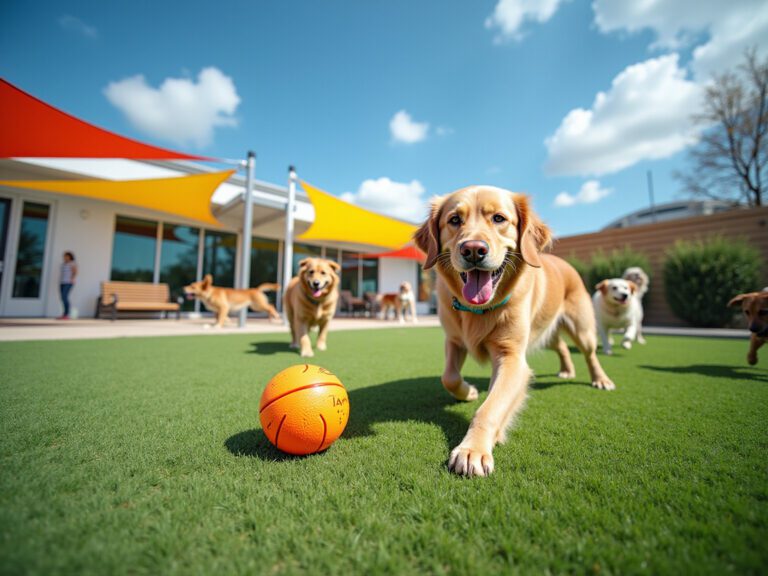Can Dogs Have Salmon? Safe Feeding Tips for Your Pet
Overview
As a loving pet owner, you may wonder if your furry family members can enjoy salmon. The good news is that when properly prepared, salmon can be a safe and nutritious addition to your dog’s diet. Packed with omega-3 fatty acids, salmon promotes skin health and overall well-being, making it a wonderful treat for your beloved companion.
However, it’s essential to prioritize your pet’s safety. Cooking salmon thoroughly is crucial to eliminate harmful parasites that could affect your dog’s health. Before introducing this delicious fish into your dog’s meals, consulting with a veterinarian can provide peace of mind, ensuring that this addition is both safe and beneficial.
At Adventure Den, we understand the importance of nurturing your pet’s health. By taking these precautions, you can confidently offer your dog the many benefits of salmon, creating a happier and healthier life for your furry friend. Remember, your pet deserves the best, and we are here to support you every step of the way.
Introduction
Many pet owners find themselves pondering whether their beloved dogs can enjoy salmon, especially considering the fish’s rich nutritional profile. Salmon, packed with omega-3 fatty acids, can contribute to healthier skin, a shiny coat, and improved overall wellness for your furry family members. However, the journey to safely incorporating this tasty treat into a canine diet can be challenging, particularly when it comes to raw or undercooked fish.
How can you, as a caring pet owner, navigate these potential risks to ensure your pets reap the benefits of salmon while avoiding serious health issues?
Determine If Dogs Can Eat Salmon
When prepared with care, many people ask, can dogs have salmon, as dogs can truly enjoy fish. This nutritious choice is rich in omega-3 fatty acids, which support healthy skin, a glossy coat, and overall well-being for your furry family members. For example, medium-sized dogs (31-50 pounds) can safely enjoy 3-4 ounces of fresh, cooked, boneless fish each week, while larger breeds (51-90 pounds) can have 4-6 ounces.
However, it’s important to approach raw or undercooked fish with caution, as it may contain harmful parasites and bacteria that can lead to serious health issues, including poisoning disease. This condition can be quite severe, with a staggering 90 percent of untreated cases resulting in death within 14 days. To ensure your pet’s safety, always prepare fish thoroughly to an internal temperature of at least 145 degrees Fahrenheit and remove all bones before serving.
Consulting with a veterinarian before introducing new foods into your dog’s diet is always a wise step. When including fish, remember that it should make up no more than 10 percent of your dog’s total daily calories. It’s best to avoid smoked fish due to its high salt content, which can pose risks to your pet’s well-being. On a positive note, salmon skin is safe for canines, leading us to wonder, can dogs have salmon as a delightful addition to their meals?
By following these guidelines, you can confidently add fish to your dog’s diet, reaping the benefits while minimizing risks. Your commitment to their health and happiness is what truly matters.
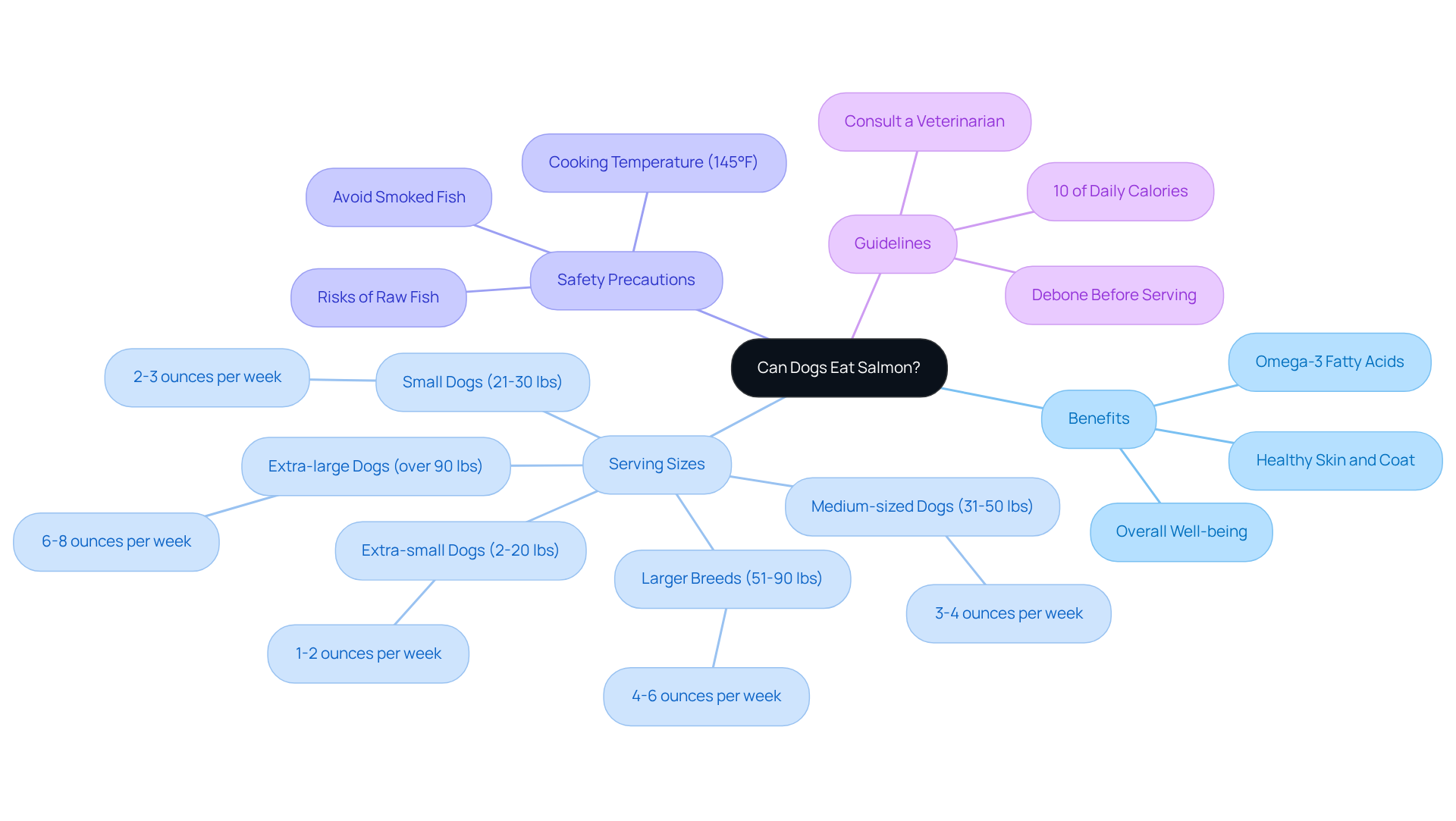
Explore Nutritional Benefits of Salmon for Dogs
Salmon is a powerhouse of essential nutrients that can significantly improve your furry family member’s well-being. As an excellent source of high-quality protein, it plays a crucial role in muscle development and overall vitality. Rich in omega-3 fatty acids, this fish helps reduce inflammation, promotes a lustrous coat, and supports cardiovascular health. These fatty acids, particularly EPA and DHA, are vital for maintaining healthy cell membranes and can improve skin conditions by alleviating dryness and irritation.
In addition to omega-3s, this fish is packed with B vitamins, which are essential for energy metabolism and a healthy nervous system. The antioxidants present in fish, such as astaxanthin, further contribute to immune support by combating free radicals.
Practical instances demonstrate the beneficial effects of fish on canines’ well-being. For example, numerous pet owners share heartwarming stories of their dogs enjoying enhanced coat quality and fewer skin problems after including fish in their meals. Products like Salmon Bleu, made from sustainably sourced New Zealand King Salmon, are designed to provide these health benefits while ensuring safety and quality.
Expert opinions underscore the importance of omega-3 fatty acids in canine nutrition. Veterinarians frequently suggest that when considering a dog’s diet, pet owners often wonder, can dogs have salmon, as it can be a helpful component, especially for those with skin sensitivities or inflammatory conditions. However, it is crucial to introduce the fish gradually and ensure it is cooked thoroughly to eliminate any harmful parasites, particularly when asking the question, can dogs have salmon? Furthermore, pet owners ought to seek advice from a veterinarian before incorporating fish into their dog’s meals to ensure it satisfies their specific nutritional requirements, especially regarding whether can dogs have salmon. By doing so, pet owners can help their dogs enjoy the numerous advantages that fish has to offer.
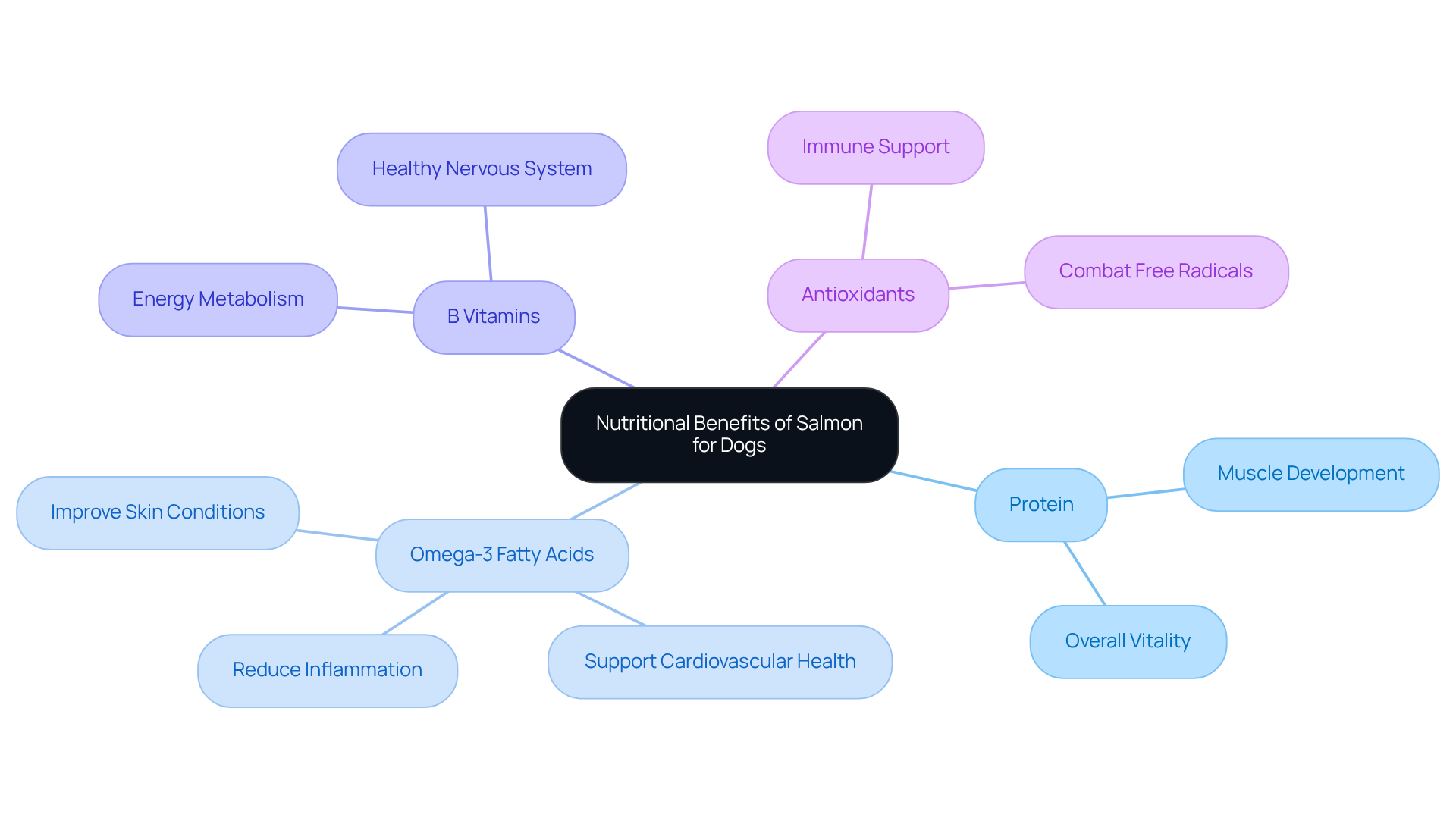
Identify Risks and Precautions When Feeding Salmon
Including fish in your dog’s diet can offer numerous health benefits, but it’s important to know if can dogs have salmon and be aware of the potential risks. Raw or undercooked fish may contain parasites like Neorickettsia helminthoeca, which can lead to poisoning disease—a serious and potentially fatal condition. Symptoms of this illness include:
- Vomiting
- Diarrhea
- Lethargy
Many dogs may be affected each year. To help keep your furry family members safe, always ensure that the fish is cooked thoroughly to an internal temperature of 145°F (63°C) and served boneless.
Additionally, it’s wise to avoid feeding your dog smoked fish, as it often contains high sodium levels and other harmful additives. Observing your pet for any negative reactions when introducing fish is crucial, as some dogs may have allergies that manifest as scratching or digestive issues. Consulting a veterinarian before making any dietary changes is highly recommended to ensure the new food meets your dog’s specific health needs.
For portion control:
- Small dogs can safely enjoy 2-3 ounces of fresh, cooked, boneless fish per week.
- Extra-large dogs can have 6-8 ounces.
By taking these precautions, you can safely embrace the nutritional benefits of fish while ensuring your beloved companion remains healthy and happy.
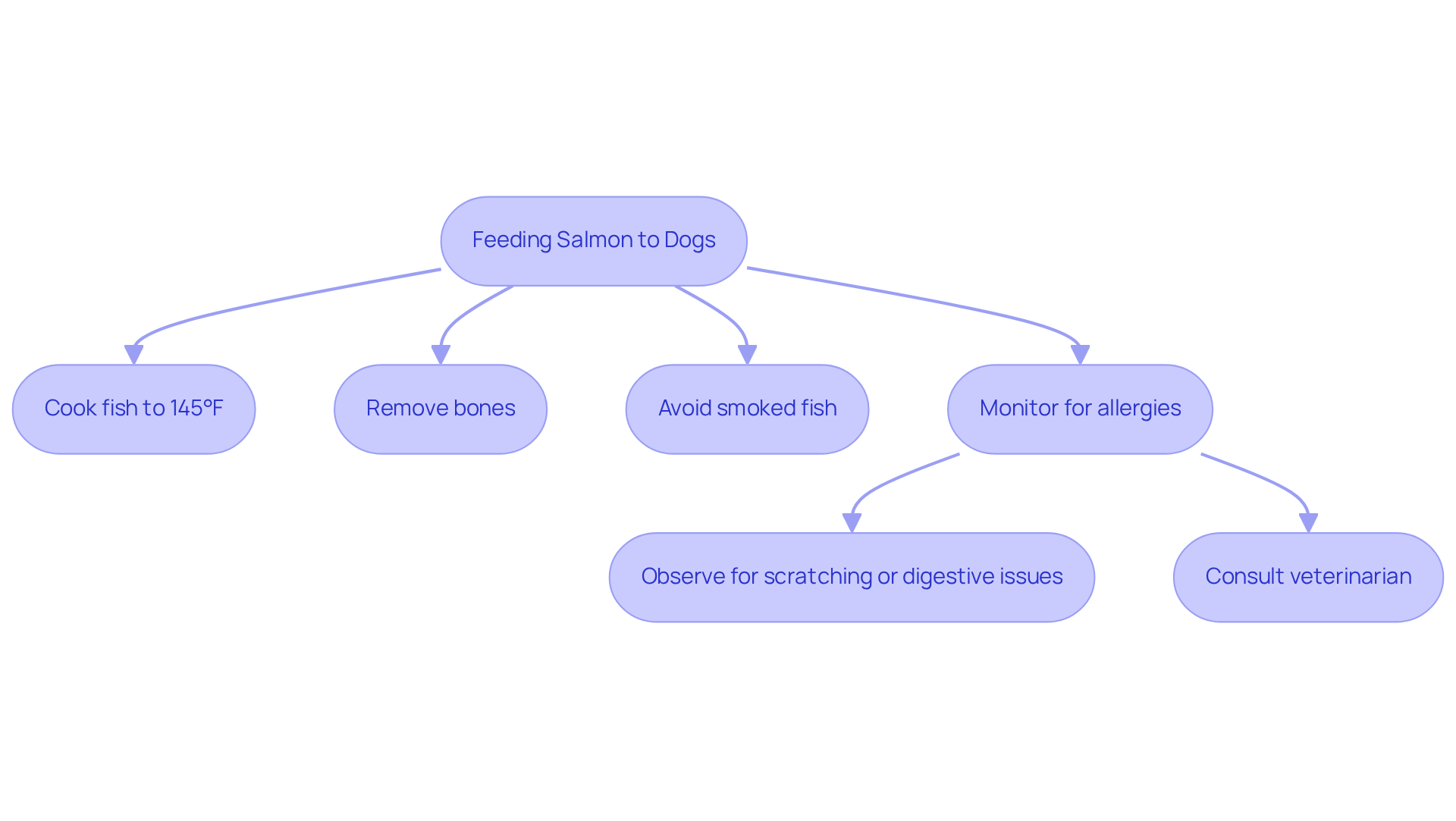
Learn Safe Preparation and Serving Methods for Salmon
To safely prepare fish for your furry family member, follow these nurturing steps:
-
Choose fresh, boneless fish fillets, ideally wild-caught, to ensure better nutritional value for your beloved pet.
-
Cook the fish thoroughly using safe methods such as baking, grilling, or poaching until it reaches an internal temperature of 145°F (63°C). For instance, baking at 350°F for 15-20 minutes or grilling on medium heat for 10-15 minutes are effective ways to prepare it. Remember to avoid any seasonings, especially garlic and onion, as they are toxic to dogs. While dogs can enjoy cooked and unseasoned fish skin, it’s best to limit this to prevent excessive fat consumption.
-
Allow the fish to cool completely before serving it to your pet.
-
Cut the fish into bite-sized pieces that are suitable for your dog’s size, making it easy for them to enjoy.
-
General serving size guidelines suggest:
- Small Dogs (up to 20 lbs) – up to 1 oz;
- Medium Dogs (21-50 lbs) – up to 2 oz;
- Large Dogs (51-90 lbs) – up to 4 oz;
- Giant Dogs (over 90 lbs) – up to 6 oz.
Serve fish as an occasional treat, ideally once a week, to maintain a balanced eating plan and avoid any digestive discomfort. It’s also important to be cautious, as providing raw or undercooked fish can pose risks, including fish poisoning disease. By following these caring guidelines, you can find out if dogs can have salmon safely incorporated into their diet, enhancing their overall health and happiness.
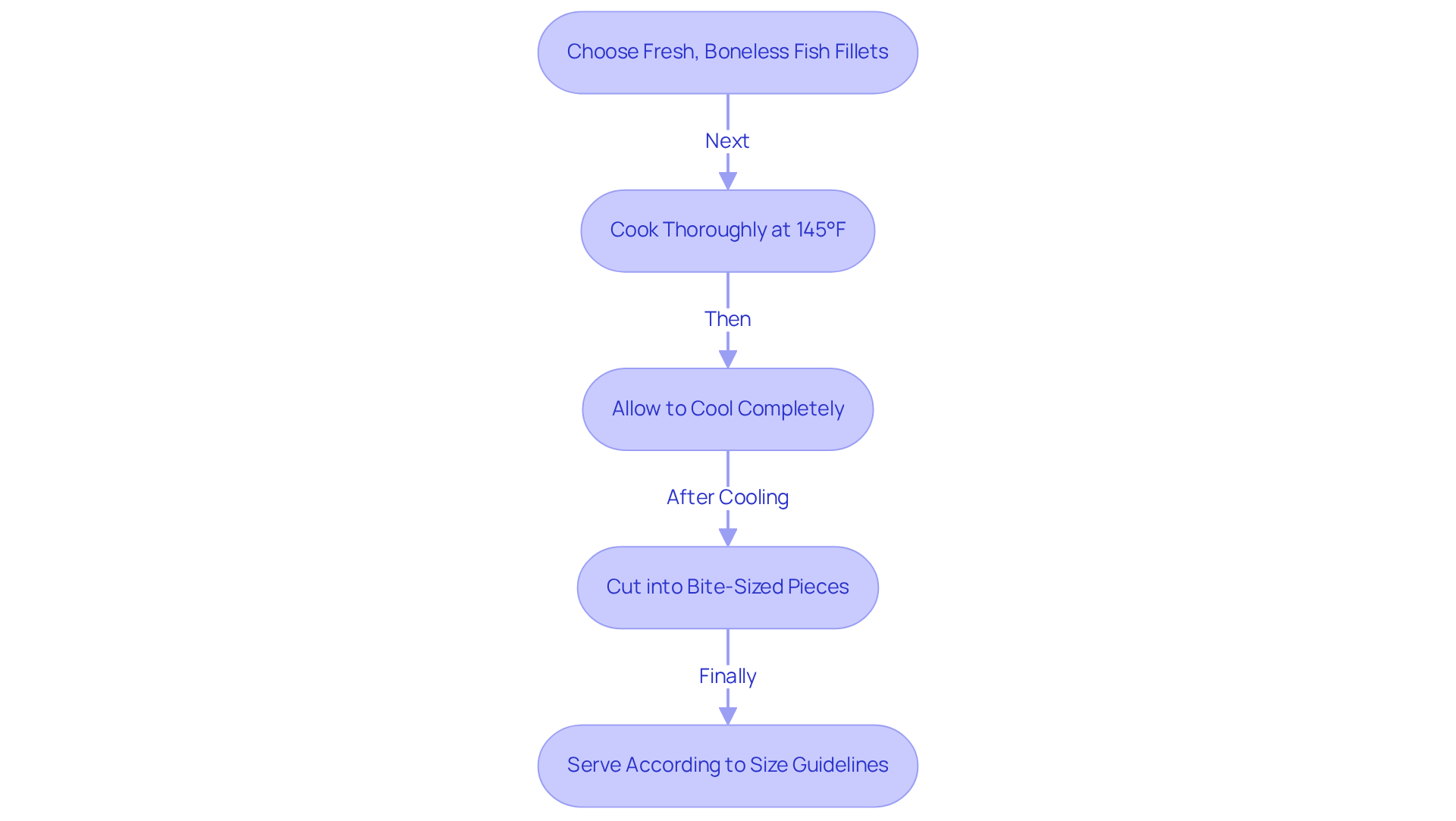
Conclusion
Including salmon in your furry family member’s diet can be a delightful and nutritious choice, provided it is prepared and served correctly. This fish is rich in omega-3 fatty acids, which contribute to healthy skin and a shiny coat, while also offering essential proteins and vitamins that support overall canine health. By understanding the proper ways to include salmon, you can enhance your pet’s diet without compromising safety.
It’s essential to cook salmon thoroughly to eliminate harmful parasites and bacteria that can pose serious health risks. Safe preparation methods, recommended portion sizes based on your dog’s weight, and the potential dangers of feeding raw or smoked fish are crucial considerations. Consulting with a veterinarian before introducing new foods ensures that your dog’s specific dietary needs are met, allowing for a healthy and enjoyable experience.
Ultimately, the decision to include salmon in your dog’s diet should be made with care and consideration. By following the guidelines provided, you can confidently add this nutritious fish to your pet’s meals, reaping the benefits while minimizing risks. Embracing a balanced diet that includes safe, cooked salmon can lead to happier and healthier dogs, reinforcing the bond between you and your pet through shared, wholesome experiences.
Frequently Asked Questions
Can dogs eat salmon?
Yes, dogs can eat salmon when it is prepared properly. It is a nutritious choice rich in omega-3 fatty acids, which support healthy skin, a glossy coat, and overall well-being.
How much salmon can dogs safely consume?
Medium-sized dogs (31-50 pounds) can safely enjoy 3-4 ounces of fresh, cooked, boneless salmon each week, while larger breeds (51-90 pounds) can have 4-6 ounces.
What precautions should be taken when feeding dogs salmon?
Raw or undercooked salmon should be approached with caution as it may contain harmful parasites and bacteria. Always prepare salmon thoroughly to an internal temperature of at least 145 degrees Fahrenheit and remove all bones before serving.
What are the risks of feeding dogs raw or undercooked salmon?
Feeding dogs raw or undercooked salmon can lead to serious health issues, including poisoning disease, which can be severe and has a 90 percent untreated case fatality rate within 14 days.
Should I consult a veterinarian before introducing salmon to my dog’s diet?
Yes, it is always wise to consult with a veterinarian before introducing new foods into your dog’s diet.
How much of a dog’s daily calories should come from fish?
Fish should make up no more than 10 percent of your dog’s total daily calories.
Is smoked salmon safe for dogs?
It is best to avoid smoked salmon due to its high salt content, which can pose risks to your pet’s well-being.
Can dogs eat salmon skin?
Yes, salmon skin is safe for dogs to eat.




